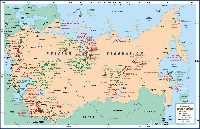FSU/ Eastern Europe: Other FSU republics
August 2000 Vol. 221 No. 8 International Outlook FSU/EASTERN EUROPE Interfax Petroleum Agency, Moscow Other FSU Republics Although it is a transit corri
FSU/EASTERN EUROPEInterfax Petroleum Agency, Moscow Other FSU RepublicsAlthough it is a transit corridor for oil and gas produced elsewhere, Georgia’s E&P sector is not well developed. Oil output last year was about 2,000 bpd. Yet, Georgian experts believe that production could rise to between 20,000 and 69,700 bopd within five years. In the east, and under development by Frontera Resources, Taribana is the leading oil field, yielding 725 to 870 bopd. However, production should rise quickly to about 2,900 bopd. Frontera plans to drill 10 horizontal wells using existing bores. Depth of the first four Teribana wells is 11,482 ft, and they will cost $70 million to $80 million. Frontera also plans to drill at two adjacent fields. Frontera has invested $30 million in the project, of which $5 million went to exploration and the rest for rehabilitation of existing wells.
On Georgia’s Black Sea shelf, Anadarko Petroleum signed a PSA to explore three offshore blocks and drill up to 25 wells. Gas reserves at Ninotsminda field onshore are being developed at the expense of America’s AES Silk Road, which owns two energy blocks at the Tbilisi power station (Georgia’s largest). British-Georgian GBOC is carrying out the field’s operations. Lithuania produced 4,641 bopd in 1999 (down 15.2% from 1998’s level) and plans to maintain that level this year. Leading producer, Geonafta, contributed about 1,000 bopd last year for export to Poland. An 81.26% governmental stake in the firm was sold for $13 million to the Naftos Gavyba consortium – Poland’s Petrobaltic and Energopol Trade, Swiss Arada and two Lithuanian companies. The consortium must invest $14 million in Geonafta. Other output comes from Lithuanian-Swedish Genciu Nafta, a 50%–50% JV between Geonafta and Svenska Petroleum Exploration; and from Lithuanian-Danish Minijos Nafta, another 50% / 50% JV formed by Geonafta and Dansk Olie & Naturgas A/S. Oil output is concentrated onshore in the western regions (Klaipeda, Kretinga and Shilut). Geonafta produces at Girkaliai field and is testing output at Kretinga and Nausodziai fields. Genciu Nafta is developing Genciai field, and Minijos Nafta is producing at Gargzdai field. In addition, officials awarded a license to develop new fields (Albinga and Vezaiciai) near Klaipeda to Manifoldas, whose leading shareholder is Russian-Lithuanian JV Stella Vitae. Only one well was drilled, a 7,959-ft oil completion. However, six wells are forecast this year. Proved oil reserves are 38.5 million bbl, said Lithuania’s Ministry of Economy. Most of the 19 oil fields are small, with reserves under 1 million t (7.3 million bbl), each. Tajikistan has produced about 400 bopd and 3.4 MMcfgd annually for the last 10 years. Of the nation’s 24 fields, 16 have been developed and were brought into production in the 1950s. No new fields have been found since 1985, except for gas wells at Khodzhasarteze and Kulyabe in the southeast, where output is utilized locally. No exploration has occurred in Tajikistan in the 1990s, due to a lack of funds and necessary personnel. Only four of 23 drilling rigs are operating. An estimated $150 million is needed to resolve critical issues in the E&P sector. Ninety percent of reserves are in the south and lie at depths of about 23,000 ft, but Tajikistan is only equipped to drill to 18,000 ft. Most equipment on hand has largely outlived its service life. Kyrgyzstan’s oil and condensate output was 1,530 bpd last year, down from 1,535 bpd in 1998. Gas production was 2.42 MMcfd, up from 1.73 MMcfd in 1998. No other data are available. Armenia has no major reserves. The viability of exploring five zones is being discussed. Armenian-American Exploration Co. has conducted seismic surveys at the Oktemberyanskoye tract and has recommended drilling one or two wells to 9,850 ft. Latvia and
Estonia do not produce any oil. However, Latvia plans to tender rights to explore and produce on its
Baltic shelf this year, if the appropriate legislation is approved in time. In Moldova, no hydrocarbon fields
are being developed.
|
|||||||||||||||||||||||||||||||||||||||||||||||||||||||||||||||||||||||||||||||||||||||||||||||||||||||||||||||||||||||||||||||||||||||||||||||||||||||||||||||||||||
- Applying ultra-deep LWD resistivity technology successfully in a SAGD operation (May 2019)
- Adoption of wireless intelligent completions advances (May 2019)
- Majors double down as takeaway crunch eases (April 2019)
- What’s new in well logging and formation evaluation (April 2019)
- Qualification of a 20,000-psi subsea BOP: A collaborative approach (February 2019)
- ConocoPhillips’ Greg Leveille sees rapid trajectory of technical advancement continuing (February 2019)



